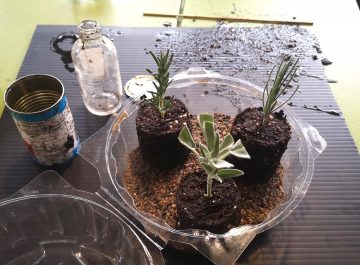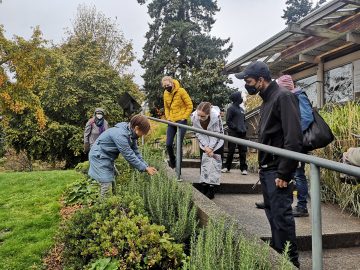The last postcard from my series Grow Plants, Change Your Life was mailed out to subscribers in November. This marked the end of my artistic residency at UBC Botanical Garden and since then I have been reflecting on what I have learned in my two years of exploring the art of plant propagation. Those explorations started with a series of conversations with Garden staff (see my series of blog posts, “An Education in Propagation”), progressed through some workshops, a community design project and finally, experiments with home propagation (a process which served as the basis for the postcard project). As my understanding of propagation grew, my sense of its significance expanded: I began to see it in terms that were not only horticultural and environmental but also personal and political. As I wrote in my final postcard, “…propagation—like everything—is, in the first place, about our relation to land.”
In this final blog post of my residency, I reflect on this change in my perspective and the potential for propagation to become a practice with an impact beyond individual gardens.

Successfully rooted sage cutting with author’s patio garden in the background.
At the beginning of my residency, I wrote about the fact that propagation depends on a variety of human and non-human relationships. However, there is a big difference between understanding this in the abstract and living it. Some of those relationships are difficult to establish, and there is a hidden politics of propagation that can be surprisingly challenging to engage. For example, in an introductory workshop I hosted early in my residency, we talked about plastic pollution and the way home propagation could drastically reduce plastic consumption among gardeners. This sounds like a practical, environmentally beneficial proposition, but given we live in a capitalist society, it is also mildly countercultural.
As I explored with Jingzhou Sun in a subsequent community design project called Plant Propagation for the People, the fact that propagation takes considerably more time than purchasing seedlings in plastic pots, means that it entails a small but profound shift in the way you organize your days. This shift can be difficult to accomplish in a society that prioritizes economic productivity and sees gardening as a leisure activity. For many of us, there is substantial pressure to work as much as possible and to consume rather than produce the materials of daily life (such as plants, or food). This makes home propagation a political as well as a horticultural practice, however much you enjoy it or gain from it personally. Jingzhou and I came to see it as an opportunity for gardeners not only to reduce unintended environmental impacts but also to increase local connections—both within their gardens and in exchanges with other gardeners. Particularly when it is approached creatively and makes use of traditional practices (as Jingzhou and I explored), it can be a tool for creating a new kind of community—one that includes a diversity of human and non-human beings.

Propagation case made from re-used materials in a workshop that was part of the Plant Propagation for the People project. The perennial cuttings are stuck into soil blocks that were formed using a tomato paste can and chop sticks. Photo by Jingzhou Sun.

Plant Propagation for the People workshop participants learning how to take cuttings from rosemary plants. Photo by Tara Moreau.
Of course, the broader political potential of propagation is disguised by the fact that most people garden in private spaces and experience their gardens in deeply personal ways. Looking back at the postcards that resulted from my experiments at home for example, I am struck by how much of what ‘happened,’ turned on personal feelings—of pleasure, disappointment and surprise (which I expected), but also regret, irritation and loneliness (which I did not).
These emotions made me uncomfortable at times, but what I eventually came to understand was that they were arising precisely because of my desire to create change in the world—and because of the barriers I encountered in trying to do so. In particular, learning to propagate required that I grapple in a very concrete, embodied and ultimately emotional way with the lack of time, space and social connections that life in a city like Vancouver often entails. It was in the process of reflecting on my emotional reactions— negative as well as positive—that I was able to see the deeper significance of those barriers, and how I might expand the impact of my gardening.
For example, one of the reasons I saw propagation as a tool for building community, is that it requires you to make connections with other people: you can’t buy cuttings or divisions, and when you start plants from seed, you inevitably end up with more seedlings than you can plant. However, as someone who lives in temporary housing, where people are constantly moving in and out, and where many lack the time and space to make a garden, it was not easy to make the connections that propagation required. Most of the exchanges I made were with people I never saw again. Sometimes those people did not seem to fully appreciate what I was giving them, and I almost never found out what became of the plants afterwards. Consequently, the repeated effort of reaching out sometimes left me feeling disconnected and lonely. I was trying to find a community that was just not there—or at least, not exactly where I was looking.
As I reflected on and wrote about these feelings, I began to suspect I was grappling with alienation that was deeper than I had previously appreciated—I was disconnected not just from people but from the land. To be a gardener in the sense that most non-indigenous people are is to care for plants (and other living beings) while in a highly constrained and problematic relation to land—that is, to land as something that can be taken from one group of people and then given, sold or rented to others. This history, and an increasing scarcity of publicly accessible spaces for gardening, make it difficult to experience the land as a site of shared abundance or meaning. It is no wonder that my attempts at making connections with other gardeners sometimes felt inadequate or inconsequential.
This is not to say that the project was not worth doing. In my year of propagating, I managed to cultivate a more expansive sense of belonging to the place in which I garden. In this, I was both inspired and humbled by the way indigenous cultures relate to land. In the last postcard of Grow Plants, Change your Life, I wrote,
Secwepemc Ktunaxa activist Kanahus Manuel says, “land is home.” But where is land if you are an apartment-dwelling settler? Maybe that is the wrong question. What can I give? Pollen for bees, seed heads for birds, tomato seedlings for anyone who asks. If land is more than the ground on which I stand, perhaps it includes all those things and beings, people and processes, I might previously have considered beyond my concern and care.

Bee-friendly flowers and flowering mesculin greens in the author’s patio garden.
Now I wonder if there is a way for propagation to move me toward an even broader sense of belonging—one that takes some measure of responsibility, not just for the land on which I garden, but also for the well-being of those who care for land in other places, particularly those with the knowledge that is older and deeper than my own. Just as I celebrate the gifts I give to pollinators, birds, and the people around me, I can also develop practices of support and respect for indigenous caretakers and land defenders. For example, attending a rally or march, writing to politicians, educating myself about the effects of colonialism and speaking bravely about it to others—I now see that these are also acts of propagation. With my learning, my words and my presence in spaces of resistance, I can make new solidarities, and perhaps these will eventually allow me to give more to—and receive more from—the land on which I grow.
As I leave my role as artist in residence, I ask you to contemplate the prospect of a world in which more gardeners see their work from this larger perspective. What if we learned how to give, not only cuttings, seeds and divisions but also—to the extent we are each able—our time, our bodies and our voices? Every gesture we make on behalf of plants and the people who care for them makes the world a bit greener, and, I think, much more hopeful.

Self-seeded nasturtium growing out of a crack between patio stones.

Thanks Erin for your contributions to the Garden and for this wonderful summary of your learnings and reflections.